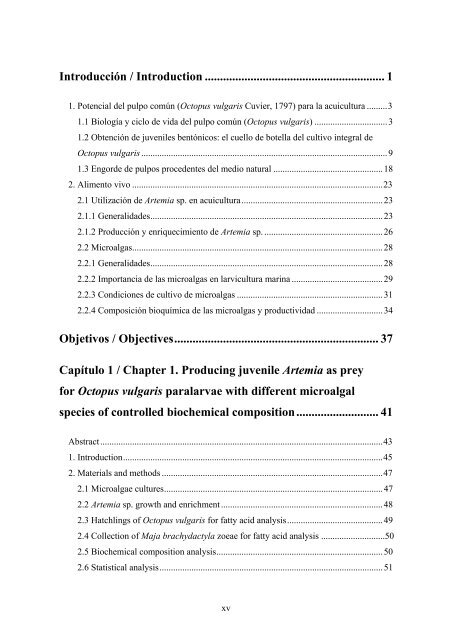Composición bioquímica y crecimiento de paralarvas de pulpo ...
Composición bioquímica y crecimiento de paralarvas de pulpo ...
Composición bioquímica y crecimiento de paralarvas de pulpo ...
You also want an ePaper? Increase the reach of your titles
YUMPU automatically turns print PDFs into web optimized ePapers that Google loves.
Introducción / Introduction ........................................................... 1<br />
1. Potencial <strong>de</strong>l <strong>pulpo</strong> común (Octopus vulgaris Cuvier, 1797) para la acuicultura .........3<br />
1.1 Biología y ciclo <strong>de</strong> vida <strong>de</strong>l <strong>pulpo</strong> común (Octopus vulgaris) ................................3<br />
1.2 Obtención <strong>de</strong> juveniles bentónicos: el cuello <strong>de</strong> botella <strong>de</strong>l cultivo integral <strong>de</strong><br />
Octopus vulgaris ............................................................................................................9<br />
1.3 Engor<strong>de</strong> <strong>de</strong> <strong>pulpo</strong>s proce<strong>de</strong>ntes <strong>de</strong>l medio natural ................................................18<br />
2. Alimento vivo ..............................................................................................................23<br />
2.1 Utilización <strong>de</strong> Artemia sp. en acuicultura..............................................................23<br />
2.1.1 Generalida<strong>de</strong>s......................................................................................................23<br />
2.1.2 Producción y enriquecimiento <strong>de</strong> Artemia sp. ....................................................26<br />
2.2 Microalgas..............................................................................................................28<br />
2.2.1 Generalida<strong>de</strong>s......................................................................................................28<br />
2.2.2 Importancia <strong>de</strong> las microalgas en larvicultura marina ........................................29<br />
2.2.3 Condiciones <strong>de</strong> cultivo <strong>de</strong> microalgas ................................................................31<br />
2.2.4 <strong>Composición</strong> <strong>bioquímica</strong> <strong>de</strong> las microalgas y productividad .............................34<br />
Objetivos / Objectives................................................................... 37<br />
Capítulo 1 / Chapter 1. Producing juvenile Artemia as prey<br />
for Octopus vulgaris paralarvae with different microalgal<br />
species of controlled biochemical composition........................... 41<br />
Abstract............................................................................................................................43<br />
1. Introduction..................................................................................................................45<br />
2. Materials and methods .................................................................................................47<br />
2.1 Microalgae cultures................................................................................................47<br />
2.2 Artemia sp. growth and enrichment.......................................................................48<br />
2.3 Hatchlings of Octopus vulgaris for fatty acid analysis..........................................49<br />
2.4 Collection of Maja brachydactyla zoeae for fatty acid analysis ............................50<br />
2.5 Biochemical composition analysis.........................................................................50<br />
2.6 Statistical analysis..................................................................................................51<br />
xv

















